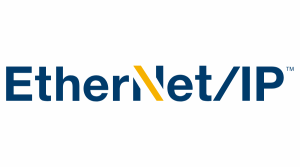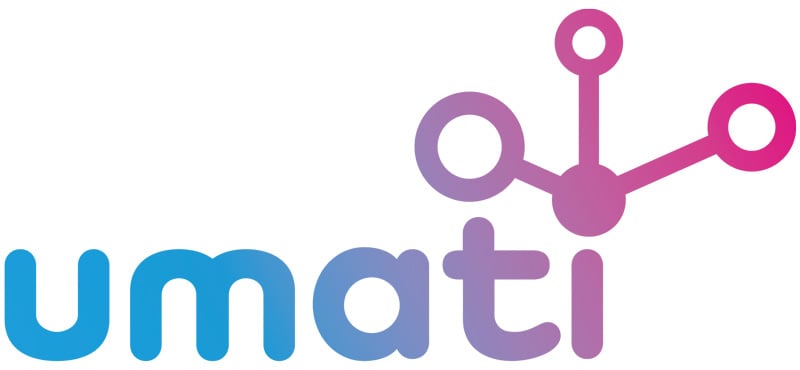Connect Sensors and Actuators with IO-Link
IO-Link is a globally-recognized point-to-point serial communication protocol used to communicate with sensors and actuators.
There are tens of thousands of IO-Link sensors on the market that enable users to capture equipment and environmental conditions, such as ambient temperature, humidity, and coolant levels.
This ensures manufacturers have access to key data points that may not be accessible via a direct connection to a machine control.
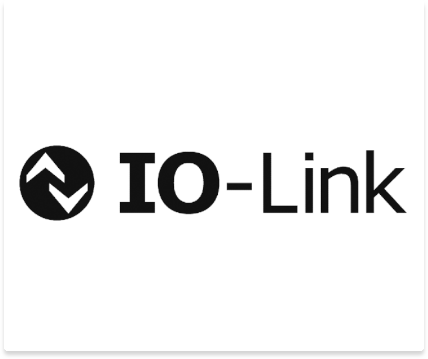
IO-Link: Collecting Data from Sensors and Actuators
What is IO-Link?
IO-Link is an industrial communications protocol that connects sensors and actuators to next-level or higher-level controllers like PLCs. This enables communication between an automation system and sensors and devices. IO-Link performs very well in a digital environment because it is both bi-directional and point-to-point.
There are over 26,000 IO-Link sensors from multiple providers that manufacturers can add to their machines and environments to capture data points. These IO-Link sensors are a valuable component of many automation initiatives as they enable access to key data points that have historically been difficult to collect.
MachineMetrics enables customers to collect native sensor data through the machine control in order to understand what is happening with the machine itself. To build on this knowledge and gain more comprehensive insight into the conditions surrounding the machines, customers can use MachineMetrics' IO-Link connector in tandem with IO-Link sensors and an ifm master to capture the environmental variables that are not measured via the machine control - such as ambient temperature, humidity, and coolant temperature - and create accompanying workflows to take action on that data.
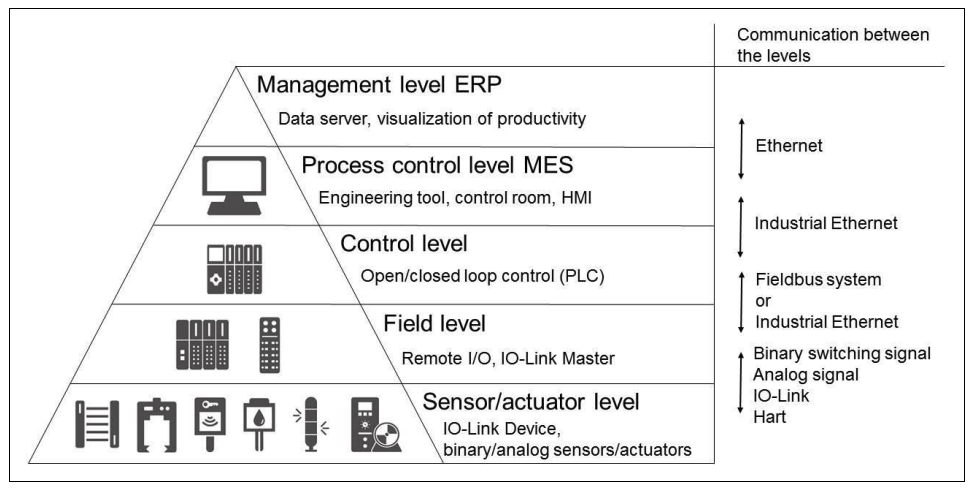 The Automation Pyramid from the IO-Link Design Guideline demonstrates how "IO-Link provides for the digitalization of the "last metre" of the communication link to sensors and actuators."
The Automation Pyramid from the IO-Link Design Guideline demonstrates how "IO-Link provides for the digitalization of the "last metre" of the communication link to sensors and actuators."
What Types of Data Can be Processed with IO-Link?
- Process Data: Addresses the current state of the sensor or actuator.
- Service Data: Information about the device itself, including configuration information, diagnostics, or status.
- Event Data: Data that isn’t included in process data because the event may be rare or non-critical.
What is IO-Link Used For?
IO-Link is a short-distance protocol that enables data collection from sensors and actuators. It’s a bi-directional and point-to-point communication protocol and is typically used for the monitoring, management, and control of sensors in the field.
This enables manufacturers to collect equipment and environmental data for nearly any data point, regardless of the data being natively available from the equipment OEM. As part of condition monitoring and maintenance efforts, manufacturers may wish to gain insight into the environmental conditions surrounding the machines. To do this, there are over 26,000 IO-Link sensors from multiple providers that manufacturers can add to their machines to capture data such as ambient temperature, humidity, and coolant temperature. For example:
Coolant Flow Rate Monitoring: Automatically detect when a machine’s coolant flow rate is insufficient and notify the operator to check the filter or add more cutting fluid. Benefits:
- Avoid tool breakage
- Protect product quality and reduce waste
- Improve the overall health of the machine
On the supplier side (the device makers) IO-Link enables companies to develop sensors and actuators that can collect, produce, and use massive data sets to increase accuracy, improve productivity, and optimize processes for their customers.
On the IO-Link Competency Matrix, you can review the technologies, products and services that IO-Link member companies provide. For example, Bosch-Rexroth offers a number of solutions that support IO-Link.
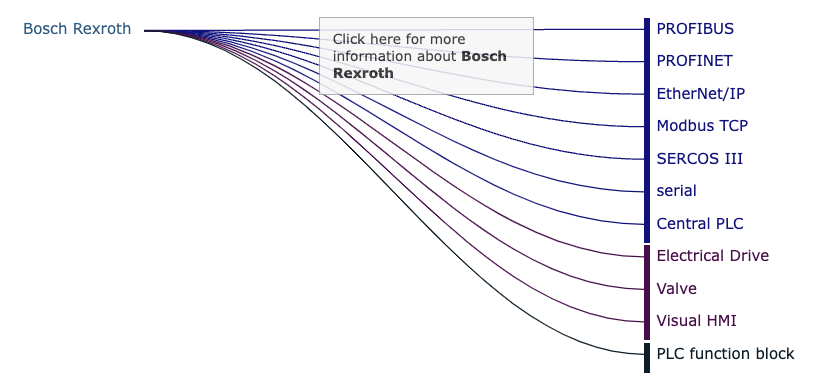
What is the IO-Link Standard?
IO-Link uses the IEC 61131-9 standard, and this standard is the same one used around the world for programming PLCs. There is an IO-Link Consortium dedicated to its promotion, enabling third-party vendors and manufacturers to develop compatible sensors and actuators that work within an IoT ecosystem with a machine data platform.
How is an IO-Link Actuator or Sensor Different from Standard I/O?
Sensors and actuators using IO-Link have broader capabilities compared to standard I/O devices. With an IO-Link device, much more data is visible to the user. Sensor settings can be changed “on-the-fly” so production lines and machines don’t need to be stopped to gain access to the sensors. Parameters can be stored in a master block so new devices and sensors can be loaded with existing parameters when added to the system.
What are the Benefits of IO-Link?
There are several key benefits to using IO-Link in conjunction with an advanced machine data platform:
- Remote Accessibility: Like many components of a machine data platform, IO-Link can be accessed remotely. This capability facilitates the changing of settings from any location.
- Automated Device Replacement: IO-Link uses a data storage feature that seamlessly transfers the old sensor’s data to a new sensor. This feature makes installation fast and straightforward.
- Diagnostics: Like remote accessibility, diagnostic data can be accessed without stopping the line. This feature enables troubleshooting and addresses issues faster with little or no downtime.
- Simple Wiring Requirements: IO-Link devices can be connected using unshielded three-wire cabling like that used in I/O devices. This feature simplifies installation and reduces the cost of changeover.
What Type of Adapter or Connector is Available for IO-Link?
Many manufacturing systems utilize an IO-Link Master module available from third-party suppliers. These master devices can process both analog and digital signals. This capability gives IO-Link two distinct advantages. One, it can be integrated into current systems and use recognizable communication protocols such as Profibus, Modbus, ProfNet, and others.
The second advantage is that IO-Link works well with machine connectivity platforms like MachineMetrics, which can autonomously standardize data across machines and devices. While MachineMetrics does require that sensors be connected specifically to an ifm master, for those that do, this ecosystem includes over 26,000 sensor types that can be linked. This enables the connection of machine assets from different generations and various OEMs.
With MachineMetrics, using an ifm Master, the link between the devices and the machine connectivity platform is quickly and readily established.
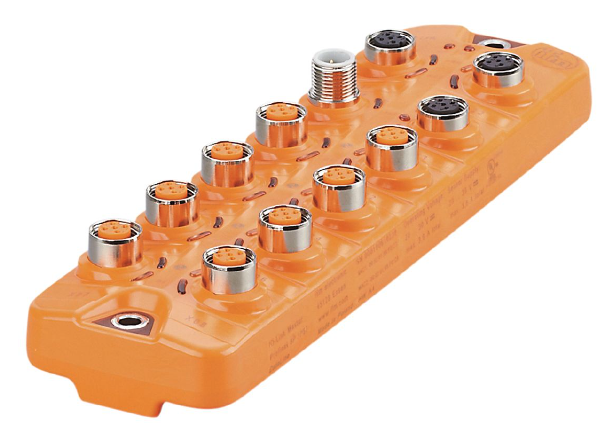 Source: ifm IO-Link master with EtherNet/IP interface
Source: ifm IO-Link master with EtherNet/IP interface
Is IO-Link Free?
While the IO-Link standard is open, there are requirements for its use by the IO-Link Consortium. Third-party vendors developing devices must have them tested for quality and pay licensing fees to include the standard in their devices.
Which Communication Protocols is IO-Link Compatible With?
IO-Link is compatible with many communication protocols. These include:
- ProfiNet
- Profibus
- ModBus
- EtherNet/IP
- IO-Link Wireless Communication
What Other Sensor Types Make up an IO-Link Device?
The most common IO-Link devices are sensors and actuators. However, several other IO-Link device types are used in diverse industrial applications.
- IO-Link hubs can be used in situations where data acquisition isn’t required, and the device simply needs to enable action.
- IO-Link Master Blocks are used to send and acquire data for more precise control situations. They also replace the need for a Fieldbus.
- IO-Link can also be used in mechatronic devices like grippers and power supplies.
- Many IO-Link devices can be manufactured with special housing to accommodate harsh manufacturing environments and temperature extremes.
How Do I Ensure Connectivity to All Devices, Sensors, and Equipment?
This is where a connectivity solution like MachineMetrics comes into play. MachineMetrics is a production monitoring platform that enables data collection and standardization from any make and model of equipment, including legacy machines.
MachineMetrics is the leading platform to collect, monitor, analyze, and drive action with manufacturing equipment data. Our platform easily captures data from your manufacturing equipment and sensors to provides a complete toolkit to drive actionable insights for frontline workers and other factory floor systems.
Whether the equipment is IO-Link compatible or not, you can easily connect and collect data across all your devices for complete operational visibility.
Want to see the platform in action? Book a Demo Today.


